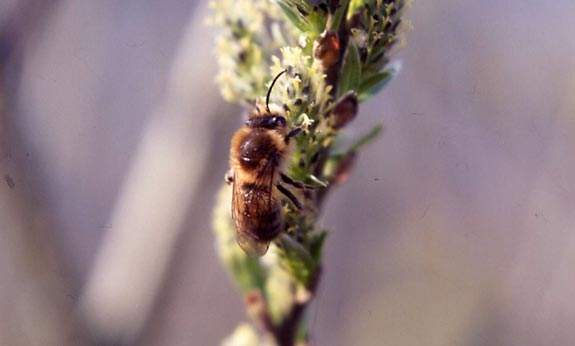MINING BEE (COLLETES CUNICULARIUS)
LOCAL BIODIVERSITY ACTION PLAN
Links to associated HAPs
None
 Current Status
Current Status
This species is confined to coastal dunes of NW England and Wales (Cumbria to Glamorgan). It is on the the Long List of priority BAP species.
Locally it is found in the sand dune system at Leasowe and Meols within the North Wirral Coastal Park.
Apart from the general provisions of the Wildlife and Coutryside Act 1981, Vernal Colletes Mining Bee is not specially protected by European or British legislation.
Threats
- Habitat loss to development.
- Habitat loss to coarse vegetation, scrub/ woodland.
- Degredation and loss of habitat due to public pressure.
- Dune stablisation schemes.
How are we helping to conserve the Mining Bee in the Cheshire region?
- CCW/BHP carry out monitoring at Talacre, Flintshire.
Objectives, Targets and Actions
OBJECTIVES |
LOCAL TARGETS |
1. Maintain current colonies.
2. Provide additional habitat for nest sites.
2. Increase areas of creeping willow. |
1. Maintain and increase creeping willow for pollen and nectar source by between 25 and 50% by December 2007.
2. Implement annual monitoring of the species. |
ACTIONS REQUIRED |
-
Ensure that the species is included in site management documents for all relevant SSSIs by 2005.
-
Colonies should be included within existing SSSI or the site should be designated as SSSI. Designate the North Wirral Coastal Park as SSSI by 2005.
-
Ensure Vernal Colletes Mining Bee's requirements are taken into account in all plans and strategies affecting the North Wirral Coast.
-
Maintain semi-fixed dunes with plenty of exposed sand that are sunny and with south facing slopes (45-85 degrees), including old blow-outs undergoing secondary colonisation, but with no bryophyte cover.
-
Maintain and increase creeping willow for pollen and nectar source.
-
Maintain open sward and control scrub.
-
Manage public around vulnerable nest sites.
-
Ensure that by end of 2003 all relevant landowners and managers of sites with Vernal Colletes Mining Bee are aware of the species needs, the importance of the species and that advice on its management is available.
-
Implement regular monitoring of the species.
-
Forward information gathered during monitoring to appropriate local and national data holders.
-
Produce and distribute a simple leaflet identifying conservation needs and aims for sand dune invertebrate species including Vernal Colletes Mining Bee.
|
Progress so far
| 1997 - 2006 Action Completed |
|
How to find out more about the Mining Bee
This plan is part of the Wirral Biodiversity Action Plan which can be viewed at www.wirral.gov.uk/ed/biodiversity/home.htm
Contact details
| LBAP Chair |
Carl Clee, NMGM
Phone: 0151 478 4283 |
References & Glossary
HMSO (1995): Biodiversity: The UK Steering Group Report, Volume 2: Action Plans, London.
HMSO (1995): Biodiversity: The UK Steering Group Report, Volume 1: Meeting the Rio Challenge, London.


 Current Status
Current Status